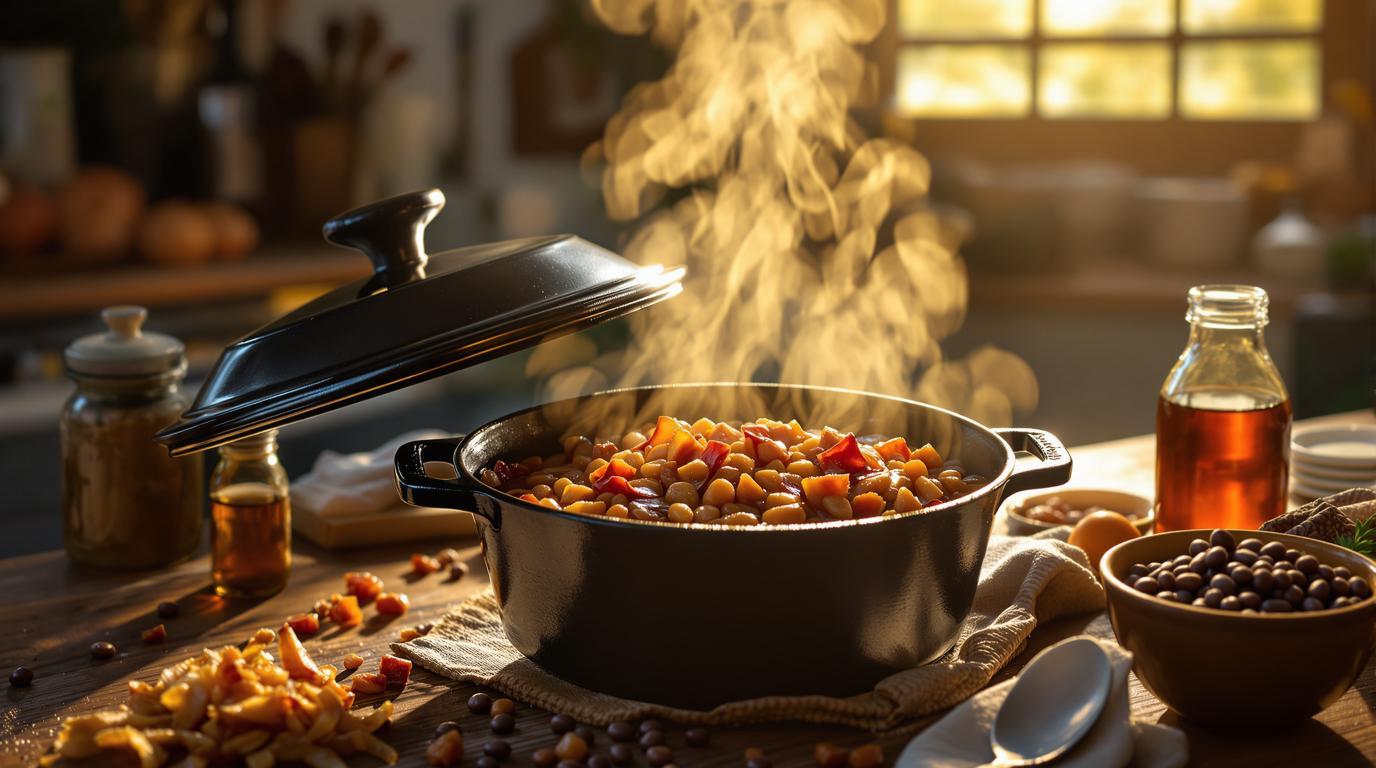The scent of slow-baked beans wafting through my grandmother’s kitchen on Sunday mornings is one of my most cherished childhood memories. Those bubbling, molasses-rich pots were a testament to both thriftiness and flavor—transforming humble ingredients into something truly extraordinary. I’ve spent decades perfecting my own version of these New England-style baked beans, which consistently beat commercial varieties in blind taste tests. The secret? A patient approach and a respect for tradition that yields deep, complex flavors from just a handful of affordable pantry staples.
The Humble Origins of Bargain Baked Beans 📖
These baked beans trace their lineage back to colonial New England, where molasses was plentiful and slow-cooking allowed families to prepare meals while observing the Sabbath. Native American bean-cooking techniques merged with European ingredients to create this distinctly American dish. What makes this version special is its reliance on basic ingredients rather than premium additions—proving that authentic flavor comes from technique, not expense.
During my culinary training, I discovered that many chefs overcomplicate this dish. The truth is, our grandmothers knew best: simple ingredients, given time and proper treatment, develop remarkable complexity. For about 50 cents per serving, you can create beans that would make any New Englander proud.
Essential Ingredients 🧾
• 2½ cups (1 pound) dried navy beans
• 1 cup (6-8 slices) diced bacon
• 1 large onion, finely chopped
• 1 cup unsulphured molasses
• ¼ cup brown sugar
• 1 teaspoon dry mustard
• 2 tablespoons tomato puree (optional)
• Salt and freshly ground pepper to taste
• Water as needed
Chef’s Note: The choice of molasses is crucial here. Unsulphured molasses provides that distinctive deep flavor without excessive bitterness. If you can find it, “robust” or “full-flavor” molasses (not blackstrap) offers the perfect balance. This is one ingredient where quality matters even in a budget recipe.
The Grandmother Method 📝
1. Soak the beans: Place beans in a large bowl and cover with cold water by at least 2 inches. Let soak overnight (8-10 hours). This patient approach ensures even cooking and tender beans. Drain and rinse before using.
2. Prepare the flavorings: In a heavy skillet, cook the diced bacon until just crisp. Remove bacon with a slotted spoon and set aside. In the rendered bacon fat, slowly sauté the chopped onion over low heat for about 30 minutes until deeply golden and sweet. This caramelization process creates natural sweetness that enriches the entire dish.
3. Combine: In a heavy, covered casserole dish or Dutch oven, combine the soaked beans, crispy bacon, caramelized onions, molasses, brown sugar, dry mustard, and tomato puree (if using). Add enough fresh water to just barely cover the beans.
4. Slow bake: Cover tightly and bake at 275°F (135°C) for 3-4 hours. Check hourly, adding small amounts of boiling water as needed to keep beans moist without making them soupy. Resist the urge to stir too frequently—this breaks the beans and makes the sauce gluey.
5. Season: After beans are tender and sauce has thickened to a rich consistency, season with salt and pepper to taste.
Chef’s Secret Techniques 🤫
For truly exceptional beans that surpass any commercial variety, I follow these professional techniques:
• Low and slow is non-negotiable — The transformation of these humble ingredients requires time. Rushing creates mealy, flavorless beans.
• Use bacon ends and pieces rather than premium bacon. These less expensive cuts actually provide better flavor for this application and render more fat for sautéing onions. Ask your butcher for these budget-friendly portions.
• The resting period matters — Allow beans to stand 15-20 minutes after removing from the oven. This rest allows the flavors to settle and the sauce to achieve perfect consistency.
If you enjoy traditional cooking techniques, you might also appreciate this fascinating method for transforming apple scraps into gourmet vinegar or this 5-minute foolproof blender mayonnaise trick.
Serving & Presentation 🍽️
Serve these beans piping hot in a rustic pottery bowl, with crusty bread for sopping up the rich sauce. They pair beautifully with simple grilled meats, a crisp coleslaw, or alongside these crispy roast potatoes. For breakfast, try them with perfectly soft-boiled eggs on toast.
For vegetarians, you can omit the bacon and sauté the onions in butter or olive oil instead. The dish will lack some smokiness but still deliver excellent flavor. Add a touch of smoked paprika to compensate if desired.
These beans actually improve with age, developing deeper flavors over 1-2 days in the refrigerator. Reheat gently with a splash of water to loosen the sauce.
My grandmother believed that good cooking wasn’t about expensive ingredients or fancy techniques—it was about patience, intention, and understanding how humble foods transform with proper care. These bargain baked beans embody that philosophy perfectly. Every spoonful connects us to generations of home cooks who created extraordinary meals from ordinary ingredients, reminding us that true culinary wisdom often resides in the simplest of dishes.
